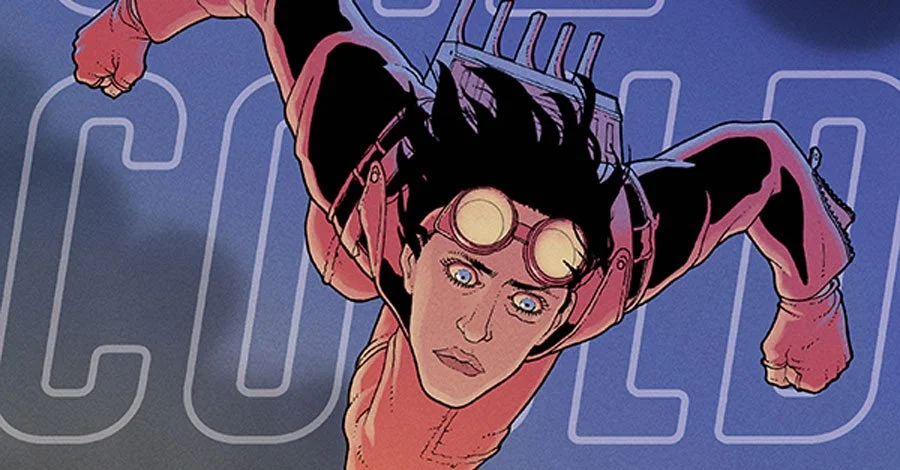Writer: Christopher Cantwell / Penciller: Martin Morazzo / Colour Artist: Miroslav Mrva / Letterer: Clem Robbins / Digital Art Technician: Adam Pruett / Designer: Richard Brunning / Editors: Karen Berger and Rachel Boyadjis Berger Books Via Dark Horse Comics
16th November 2021 (Vol. 1 Released 13th March 2019 / Vol. 2 Released 4th December 2019)
The Pitch: An unknown woman flying at fantastic speeds and spectacular heights suddenly explodes mid-air. No one knows who she was, how she flew, or why. Luna Brewster, a disturbed 15-year-old girl, becomes obsessed with learning everything about her while rumors and conspiracy theories roil. Will cracking the secrets of the Flying Woman lead to the liberation of her troubled mind?
Mental health is a cornerstone of modern stories and the modern conversation. It's easy to think that this is a new phenomenon, something that has entered comics' conciousness but that would be a falsehood. One only has to look at Moon Knight or Watchmen or, yes, even Batman to see that disturbed people have always featured in this art-form we love. And in these stories, the thing we might generalise as 'madness' is something to be feared. But the depiction of mental health has changed and continues to change. The world is now more aware and honest about what's going on underneath. How these things are presented and thereby the way we see ourselves presented in art is changing for the better, the depictions more in touch with our own experiences. Reality bleeds in and makes the world flesh. Into this arena comes She Could Fly. Nominally a story of a woman who uses a flying device to take to the skies. But what it actually is, what it reveals itself to be as it moves through it's two volumes, is the story of Luna, a disturbed young woman who finds kinship with a woman she's never met, gradually finder a balance with the darker parts of her obsessive nature, sometimes allowing them to guide her, strangely, to a place of near-stability. And this is not an easy read. A lot of the characters are unlikeable. Flawed and greedy. In some cases despicable. We're asked to follow a lead whose grip on reality is often untenable at best. Nothing about this screams modern classic you'll come to love and treasure. But it is. And you will. I know I did.
LUNA’S CONDITION AS IT MANIFESTS MAY SCARE YOU A LITTLE, BUT EMPATHY IS CRITICAL
Luna’s condition as it manifests may scare you a little. Given to repeating the word Rubberball over and over when wandering the halls of her school. You may find her intimidating. I did. And once you get inside her head and see the world as she sees it, it gets worse. She's given to visions, seeing people not as they are but what they represent to her psyche. Beyond that, she is tortured by a voice, telling her that one day she will murder her family. The torture is further embellished as the voice show her how she might do it. Luna is terrified. Of the world around her. The people in her life. Of life itself. And most of all of herself. So, empathy is automatic response. It becomes critical. But at the same time, as a reader, we're powerless to help. And the people in the framework of the story that are supposed to help just seem to be making things worse.
One of the fascinating things about both volumes of this work is that Luna's obsessiveness is allowed to actually run rampant. It takes over her life – and ours – despite the fact that every reasonable conclusion would lead anyone to not allow that. And the journey is all the more rewarding for that. Luna's goal – to take fight – becomes the goal of all of us. It's said that schizophrenic people often enjoy a feeling of weightlessness, itself not unlike flight. So we might assume that Luna is suffering from that very malady. This is a question that is never really answered. Depression seems a likely candidate with Luna, something that a lot of us (including me) may recognise in themselves. Luna isn't the only one depressed, life slowly eroding thanks to forces she can't control. You see it the characters that surround her, too. In Bill, the scientist who may sell his secrets to China for the shot at building a better life for himself. In his lover, a prostitute may or may not being using him for money or who may or may not be genuinely in love with him.
BACKGROUND CHARACTERS’ LIVES SPILL OUT INTO THE MAIN NATRRATIVE. THEY HAVE INNER LIVES OF THEIR OWN
But they're not written as cyphers. They're not just background. They have inner lives of their own that spill out into the main narrative and effect Luna's life and mental state in ways they can't predict or hope. The book sets up narrative and emotional mirrors. Luna investigates the flying woman. Bill and his paid lover investigate Luna. Their live intersect around a dead person. A person who is also depressed and found solace in flight, something that everyone else in the story yearns to do. And so the book becomes a tale of dove-tailling ambitions, all with different motives but only one outcome. Who will alleviate their sadness first and to what end? To sell technology to the Chinese and have a better life? To correct historical mistakes in the diagnosis of their own mental health (as with Luna's well-meaning counselor)? Or in Luna's case, to feel the pure exhilaration of no longer being bound to the earth? To be free not only of gravitational constraints but emotional ones too?
She Could Fly takes a young woman's true desires and makes a thrilling yarn from them. It turns what might have been a rote tale of potential super-heroism through the lens of mental health into a near-religious experience. Sprituality runs through both volumes. Although the flying woman is not a god, but someone made powerful via technology and their own abilities. A prometheus who becomes an Icarus. In volume two, we begin to move closer to a cult-like experience from an unlikely source (I won't reveal it here), as characters begin to reach back through the past, connecting to ghosts and ideas that may bring them answers (or indeed, enlightenment) today. For Luna, that enlightenment will come via flight. As she get's closer to that dream, other factors in her life begin to click awkwardly into place and yet others fall apart. Her journey is never quite complete, which is a good thing for us, since another volume is due soon.
CANTWELL weaves together disparate elements around single axis points and let's them orbit until it's time for them to collide
Cantwell writes sensitively, especially where Luna is concerned. He's mastered dual, sympathetic narratives that parallel and inform each other. His architecture and construction of story and dialogue are a joy. He weaves together disparate elements around single axis points and let's them orbit until it's time for them to collide. Morazzo creates moments of love and horror on the page, translating Cantwell's nuanced writing beautifully, switching between subjective narratives, some of which may not be real but create fear and paranoia just the same. He pushes the wide and low, making characters loom large in our minds. They walk like giants yet cower like mice. Mrva's colours are soaked into the page, creating bright and lurid moments inside people's psyches. For the real sections, the shift is palpable. Bright, yes, but more lifelike. Robbins letters convey deep, black voices from the ether, speaking from deep inside Luna's subconscious. And Luna's fragile state is essayed with perfection through her voice. You feel her fear and her elation. She Could Fly thus far has been a surprise, a subtle masterpiece I never expected. One that speaks to some of our own issues and makes that dream of flying we've all had, especially if we read comic books. I'm waiting for Volume 3. I hope I get to see you up there in the clouds, too.
Get Part Two of our look at the work of Christopher Cantwell right here. She Could Fly Volumes 1 & 2 are available from your local comic book shop now. You can buy the collected pack of Volume 2: The Lost Pilot from our webshop. Volume 3 is released soon.




